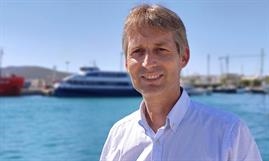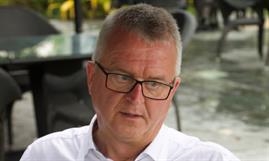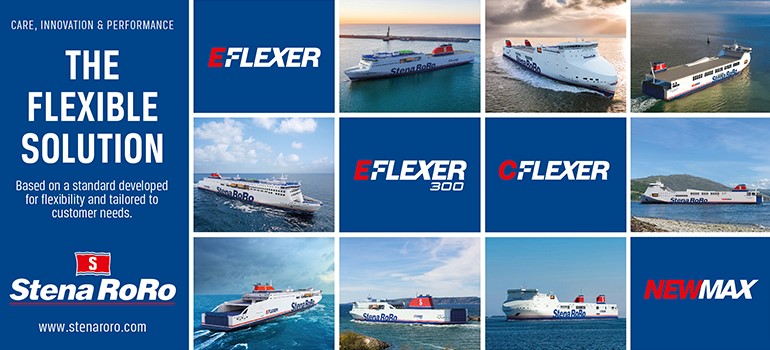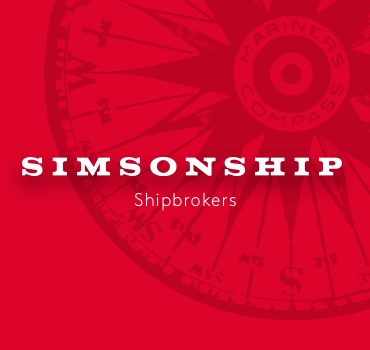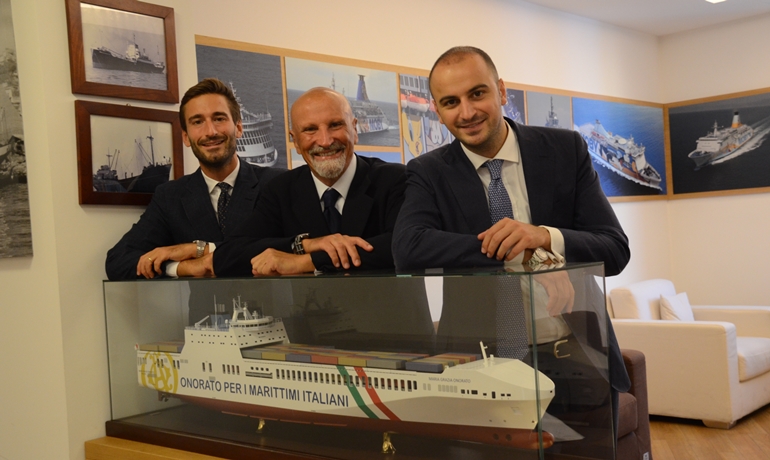
Achille, Vincenzo and Alessandro Onorato © Philippe Holthof
Moby pursues organic growth and diversification as forward strategy
InterviewThree and a half years ago Achille Onorato and his younger brother Alessandro took over the helm of Moby Group from their father, the 62-year-old Vincenzo, who remained on board, as the chairman, to help charting the progress. Shippax’s editor-in-chief spoke to the Onoratos in their Milan headquarters about the group’s organic growth and diversification strategy.
At the time of Shippax’s visit in early October, Moby Group or Moby S.p.A.* found itself in the eye of the storm following an insolvency claim by some of its bondholders. The Civil Court of Milan eventually ruled in favour of the shipowner who, in an effort to avoid an appeal, then set up a roundtable with the bondholders. Notwithstanding the group’s alleged precarious financial situation, the Onoratos faced the future with confidence.
I was initially welcomed by Alessandro Onorato, the vice president who was primarily in charge of commercial operations and sales. He showed me around the offices, the corridors of which were lavishly decorated with mainly large photos of the company’s past and present. “We have about 100 people here.” he told me. “This is a rather high number and this is mainly because we do all our IT in-house. So, most of the staff you see here are working in the IT department.”
Achille, the group’s CEO and vice chairman, and Alessandro represent the fifth generation of the shipowning empire. Moby’s office in Milan lives and breathes the rich heritage of the five generations of shipping tradition. Today, the group is primarily a ferry operator; there were times when the family operated cargo ships and tankers. There is a large picture of an Onorato tanker sailing past St. Mark’s Square in Venice decorating a wall in Vincenzo’s private meeting room.
Shortly after Alessandro had shown me around and the first authentic espresso had been served, Achille and Vincenzo joined us in the boardroom. We began reminiscing the expansion of the Moby fleet in the 1980s and the acquisition of former Belgian cross-Channel ferries. Then Vincenzo suddenly asked me if I could keep a secret. He shook my hand and invited us to do the interview in his office.
“Don’t write about what you will see and don’t take pictures,” he said, jokingly. In the main corridor that led to his corner office, he directed my attention to two photos from bygone days. “This is my father dressed as a captain,” he said, pointing at one photo, then at another. “Here he’s dressed as a shipowner.” The Onoratos have saltwater running in their veins and are understandably proud of this. “I was a seven-time world champion in sailing,” he continued, as we were walking to his office. I noticed that the windows separating the corridor from the office of his PA were tellingly marked with the initials ‘V.O.’
When a second espresso had been served and Vincenzo had lit his pipe, it was time to talk business in earnest.
Back in black soon
A lot of red ink has flown through the company’s account in recent years, but Moby’s 2019 results so far have been encouraging. “2018 was an extremely difficult year,” said Achille. “As part of our long-term strategy, we have radically changed our model to be less dependent on the passenger side of the business. We have heavily increased our presence in the freight market. Initially, you lose; but in the long term you win. Our new strategy has proved to be the right one, as we are now reaping the rewards with results that are continuously improving. As for this year, the first quarter was difficult. The demand for passenger traffic in the Mediterranean during this time of the year is always extremely low. The second quarter was good and so was the third quarter. If this trend continues in the last quarter, we may get out of the red. And, let me be absolutely clear here, this will not be thanks to the extraordinary EUR 75-million revenue from the sale of MOBY WONDER and MOBY AKI, but because we’ve succeeded in getting the business right and growing it.”
When asked whether the losses occurred mainly on the side of Moby or Tirrenia, the brand that also covered the public service contracts, Achille didn’t give a clear-cut answer. “Moby and Tirrenia are two worlds apart,” he said. “Moby operates in a free market; whereas Tirrenia operates several subsidized routes that are part of Italy’s road infrastructure, guaranteeing transport for people and goods. So, it’s a different rationale of the business. Even with subsidies, Tirrenia’s subsidized routes remain loss-making. Take a port like Arbatax, on the east coast of Sardinia, as an example. It had a throughput of just 8,000 passengers last year; but we had to call there with one of our bigger ships twice a week in winter and thrice per week in summer. This is simply not sustainable.”
Developing freight capacity
As stated above, Moby has become more freight-oriented. “Our freight network has improved a lot,” Alessandro explained. “We are gradually replacing older and less economic tonnage with more modern ships, which have better economies of scale. We have expanded our freight offering to Sardinia and to Sicily – an island with just over five million inhabitants. We have effectively started domestic Motorways of the Sea (MoS). We deliberately tapped into the freight market to create an alternative for freight customers and to be far less dependent on the passenger market, which only peaks in the summer season. Sending freight by road is becoming ever more challenging due to a shortage of drivers, rest times that have to be respected, and what have you. For this reason, demand for MoS will increase in the years to come. Admittedly, it has not been easy to enter this market, but the results are good and can only improve. In Italy we have a big fragmentation of cities and industry. The Italian truck market is also very fragmented, with many very small companies and hauliers who don’t like monopolies. So, we offered all the small companies the alternative to travel by sea and they are gradually seeing the advantages of it.”
With a rather healthy orderbook for short-sea ro-ro newbuilds, a lot of existing ro-ro vessels will become available on the second-hand market. In fact, the recent consolidation in the West Mediterranean has already rendered some fairly new and capacious vessels redundant.
“We are growing organically at the right time. The cargo market is growing and ships are available at affordable prices,” Achille expounded, adding that it would be a challenge to efficiently handle the latest 6,000-plus-lanemetre generation of super freighters in West Mediterranean ports in general, and Italian ports in particular. “On the land side, there is already a lack of space, with terminals being saturated. And unlike in Northern Europe, many Italian ports are inside the cities, not 20 or 30 kilometres from city centres. These really big ro-ro freighters will work well in the North Sea and the Baltic where they can turn ships round in a more efficient way and where terminals are adapted. I doubt it will be a success in the Mediterranean and I really wonder how they will handle them. I rather believe in a mixed fleet. You don’t necessarily have to be big on the lanemetre side; perhaps a higher frequency is more important.”
Vincenzo supported this view by adding: “We believe that a 4,100-lanemetre capacity vessel like MARIA GRAZIA ONORATO is Central Mediterranean-max size. And, actually, loading and unloading this ship within the set turnaround time is already something of a challenge.”
MARIA GRAZIA ONORATO connects Genoa with Livorno, Catania, and Malta twice a week and will be joined by the sister ship ALF POLLAK, currently still on charter to DFDS, in January. With the arrival of ALF POLLAK, there will be a tonnage reshuffle and, as part of Moby’s long-term strategy, the 1,600-lanemetre Viamare Class ships will gradually all be replaced by newer and larger tonnage.
MARIA GRAZIA ONORATO and ALF POLLAK were built by Flensburger Schiffbau-Gesellschaft, which recently delivered a third sister, LEEVSTEN, and has one more vessel in the series under construction. No charterer has yet been found for LEEVSTEN, which has been laying idle since her delivery in late August.
LEEVSTEN sports a funnel painted in pale Moby blue, but Achille earlier told Shippax that Moby would not charter the vessel. It appears that he has changed his mind. He admitted that they were in negotiation with Siem, the owners of the vessel, with the aim of chartering her and, perhaps, her sister. “The cargo market keeps on growing and the modal shift will push more trailers to our ships,” he said. “We therefore need to adapt supply to demand and are bullish about further increasing our presence in the market. The Malta call supplements the domestic route. We are examining how we can expand our business outside Italy. An example is North Africa, which, we believe, holds potentials.”
Tonnage swap
The announcement made in early September of the tonnage swap between Moby and DFDS –whereby the former would sell its 2001-built MOBY WONDER and 2005-built MOBY AKI, to the latter and, in return, would acquire the latter’s 1987-built KING SEAWAYS and 1986-built PRINCESS SEAWAYS, plus a cash consideration of EUR 75 million – caused some ripples, not in the least among Moby’s bondholders.
“The swap is very logical and is part of our ten-year vision,” said Achille. “These ships still had a good value and it was therefore the right time to sell them. This is also because we have meanwhile embarked upon building our two next-generation ro-pax ferries in China. These two new ships, together with the options we hold, represent the future. DFDS’s PRINCESS SEAWAYS and KING SEAWAYS, on the other hand, are still excellent ships that perfectly suit our passenger-intensive summer operations.”
Alessandro then chimed in and further expounded the rationale behind the deal. “With a high number of cabins, they are also a perfect fit for Tirrenia,” he said. “These ships are in very good conditions and were recently refurbished. DFDS was looking for more lanemetres and we were looking for more cabins. That’s how we found each other. With replacement already guaranteed through the double order in China, the time was ripe to sell the ships at a good price. It’s a very straightforward and logical decision.”
MOBY WONDER and MOBY AKI have already been withdrawn from service and replaced by MOBY TOMMY and MOBY DREA. “This is just a temporary solution,” Achille made it clear. “Livorno-Olbia is the most important route in our network. Right now, it’s low season; so, we don’t necessarily need ships the size of MOBY WONDER and MOBY AKI as two freighters with driver capacity form the backbone for freight carryings. Ultimately, and until the arrival of the newbuilds from China, we expect to introduce Tirrenia’s NURAGHES and SHARDEN; the capacities of which are similar to those of MOBY WONDER and MOBY AKI. We are allowed to use Tirrenia tonnage for Moby purposes, as long as the ships meet the contractual requirements and are Tirrenia branded.”
Newbuilds from China
In late June, Moby signed a contract with Guangzhou Shipyard International (GSI) for the construction of two giant ro-pax ferries, each with a capacity of 3,800 lanemetres and 2,500 passengers. With an estimated gross tonnage of 69,500, a length of 237 metres, and a beam of 32 metres, a good economy of scale is at the heart of the design. When introduced on the Livorno-Olbia artery in late 2022/early 2023, the pair will most likely replace four ships, i.e. two ro-pax ferries and two freighters. Capable of a 27-knot service speed, as built, MOBY WONDER and MOBY AKI had a surfeit of power. Such a high speed is no longer a prerequisite. The newbuilds will have a maximum speed of 23.5 knots. “Our father has been instrumental in the design of the ships,” Alessandro said. “It was developed in close cooperation with OSK-ShipTech, the ships’ naval architects, who were responsible for everything technical. We have a long-standing relationship with Anders Ørgård of OSK-ShipTech, something we cherish.”
Vincenzo chimed in at this point: “In essence the ships are a further evolution of the MOBY WONDER series which I masterminded together with Anders about 20 years ago. Obviously, much attention has been paid to the ship’s hydrodynamics. Like MOBY WONDER and AKI, the superstructure will extend right out to the stern. I got my inspiration from MOBY VINCENT, which pioneered this concept.”
MOBY WONDER and her sister MOBY FREEDOM (now Eckerö Line’s FINLANDIA) were built by Daewoo in South Korea. Fincantieri’s Ancona shipyard delivered MOBY AKI. On this occasion, according to Achille, building at Fincantieri was not an option. “Fincantieri is a world champion in passenger ship building, but it had a full cruise ship orderbook,” he said. “We visited many shipyards. We selected GSI for quite obvious reasons. This was not only because of price and the connection between OSK-ShipTech and GSI through SinoDane. GSI was the only Chinese yard having already delivered ferries to an international customer. Other major players are also building at GSI. There is a very good reason for this: they offer high quality products and they are really serious and professional people. The newbuilds would represent an investment for the next 40 years; so, we needed a reliable shipyard that could build the ships as per our high specifications. We have great confidence in the yard.”
China has become the epicentre of large-scale ro-pax vessel construction, mainly because of its competitiveness in prices, something Achille admitted. “The non-Chinese yards were more expensive, but in choosing GSI we also had the feeling that we might not be 100-per-cent satisfied with the product,” he said.
Have they learned anything valuable from operating the Wonder Class ships? “MOBY WONDER and MOBY FREEDOM were already signalling the end of the cruise ferry era in the Mediterranean,” Vincenzo explained. “Apart from the impressive three-tier front bar lounge, the ships were designed as genuine ro-pax ferries, rather than cruise ferries. It was the late Pascal Lota who first introduced the cruise ferry concept to the Mediterranean. We came later with MOBY FANTASY and MOBY MAGIC. At the turn of the century, it was again back to basics. This was also reflected in our newbuilds from Korea. We kept an à la carte restaurant; but when I travelled with the ship last month, I saw only a dozen out of a total of 2,000 passengers dining there. The new ships from China will have an impressive intake, but with a more utilitarian interior design. This doesn’t mean that it will lack decent facilities. We will have quality furniture. But we deliberately decided to keep things simple. There is no reason for them to have 12 different cabin categories and four different dining options.”
The motley fleet
In the Mediterranean, passengers typically take the ferry to go from A to B. “This is yet another reason why we already abandoned the cruise ferry concept a long time ago,” Vincenzo continued. “Unlike the freight market, the passenger market is rather flat. We have grown our market share only because we managed to win passengers from our competitors; not because the market has been growing.”
When signing the contract with GSI in June, two options were attached and the recent sale of MOBY WONDER and MOBY AKI has paved the way to exercise at least one option. “We expect to order a third newbuild in early December,” Achille revealed, “and this could quickly be followed by a fourth one.”
Notwithstanding the investment spree in new ferries, there still remain some really old ferries in the motley Moby fleet, something Alessandro didn’t regard as an issue that needed to be addressed in the short and even long term.
“Ships with high passenger and cabin capacities like MOBY DADA and MOBY ZAZA will remain in the fleet for many years to come,” Alessandro elaborated, referring to Moby’s fleet operations strategy. “They are not the newest vessels, but, then again, most of them operate in the summer only. They meet the demand and are perfect for the job. A ship only becomes old for the market when it has special issues. It would be irresponsible to invest in a new ship to replace a ship like the 1974-built MOBY VINCENT, which operates the Livorno-Bastia summer-only service. It’s a marginal market. Apparently, our competitor is of the same opinion, as it operates a sister ship of MOBY VINCENT on the same route. You should also bear in mind that ticket prices are too low to justify expensive tonnage. And, although I don’t believe that we compete head-to-head, the airlines have a big market share in bringing passengers to and from Corsica.”
Public service contract
Tirrenia was added to the Moby portfolio in 2012, but it was not until 2015 before Onorato gained full control of the former state-owned ferry operator. The integration of Tirrenia into Moby S.p.A. has been a slow process.
“And it is still not fully integrated,” Achille sighed. “Moby and Tirrenia will remain separate brands. The two companies will eventually merge for the sake of cost synergies. We have already made progress, but a complete and legal merger is still not in place. We expect this will happen in the months to come. We are still investing in the respective brands. The new freight-only routes are operated under the Tirrenia banner, for it has a very good reputation in the freight market. On the passenger side, it used to be the opposite, as the brand suffered a lot in the 1980s and 1990s, but now it’s a growing brand. We also inherited Tirrenia’s employees, whose mentality was different from that of the Moby staff. Slowly but surely we are getting there. The passenger experience has already improved a lot. We have invested in the brand and improved the onboard service with ships having been refurbished to bring them up to the Moby standard.”
In addition to the staff, brand name, and its assets, Onorato also inherited Tirrenia’s public service contract to provide vital ferry services to and from Sardinia from July 2012 to July 2020. A new tender is on the horizon and, since the assets are already in position, Tirrenia stands a good chance to extend the contract. “To operate the subsidized routes, one needs to have ships,” Alessandro explained. “Since we have the assets, we will definitely look at it, but one of the main questions will be the tonnage specifications. The current concession requires ships that are too big for rather marginal routes. As explained earlier, this is not sustainable.”
“One cannot compare apples with oranges,” added Vincenzo, “but the French have a fairer system in place for Corsica than the Italians have for Sardinia. The problem with Sardinia is that it’s way bigger and much more fragmented with many ports and has a population five times bigger than that of Corsica. Corsica’s public service contract covers just one mainland port, Marseille, with ships mostly sailing with full freight decks. We connect many ports on the Italian mainland and have to call at small ports in Sardinia. In Corsica, if you want to operate outside the public service contract, you have to do it on a year-round basis, which is fair, something that is not the case in Italy.”
Moby also controls Toremar, a one-time Tirrenia subsidiary, which guarantees lifeline services in the Tuscan archipelago. Its concession expires in 2024. Although its fleet is not new, Onorato has no plan for replacement, as the lifespan of the fleet has been extended recently. “Several Toremar vessels received major overhauls,” Achille elucidated. “It was not just another refurbishment, but new engines and auxiliaries were installed and the ships are almost like new.”
Diversification is key
Besides its ferry activities, which represent almost 93% of the consolidated revenues, Moby also controls a fleet of 18 tugboats, which, as part of a concession, guarantee harbour towage services in the ports of Sardinia. This provides about 3.7% of the total revenues with another 3.3% coming from the group’s terminal management activities. “We have long-term concessions in five Italian ports: Livorno, Olbia, Naples, Catania, and Piombino,” said Achille. “In Livorno we operate two terminals: one for ro-pax ferries and cruise ships as well as a dedicated ro-ro terminal.”
Moby’s diversification strategy has seen it joining forces with ARS Altmann, a leader in automotive logistics, in order to develop its Piombino terminal into a major car logistics hub. “Our 50/50 joint venture with ARS Altmann is a long-term partnership,” Achille went on. “We will first develop the terminal, which may eventually become the biggest car logistics hub in Central Mediterranean. We have had a partnership with Piombino for more than 60 years. This is a part of Italy that suffers a high unemployment rate. Thanks to this car logistics hub we will contribute to the local economy, as we expect to create about 100 direct jobs. The added value for the area will be more than EUR 100 million per year. In business, it’s not only about earning money; it’s also about giving back to society. So, it is important to take care of the local people. This is part of our DNA.”
In late 2016, Moby spread its wings outside the Mediterranean when it took a 51% stake in Moby SPL, a joint-venture between Moby and Baltic cruise ferry operator St. Peter Line, which held a 49% interest. The venture operates a single ship, the 1986-built PRINCESS ANASTASIA, linking St. Petersburg with Helsinki, Tallinn, and Stockholm. A weak and volatile rouble together with the difficult macroeconomic context of Russia have hampered Moby SPL’s growth and virtually halted its investment into improving its cruise ferry service. “We are quite happy with the results,” Alessandro said, “but the spending power of the Russians has dropped a lot during the last four to five years.” However, he added that the vehicle deck of PRINCESS ANASTASIA was regularly full of freight.
On consolidation
The ‘big three’ ro-pax and short-sea ro-ro operators, Grimaldi Lines, DFDS, and Stena Line, have regularly been calling for further consolidation of the still-too-fragmented European ferry market, a call that resonates with the Onoratos.
“Last year we saw a major consolidation in the ro-ro market following the take-over of U.N. Ro-Ro,” said Achille. “The name of Alternative Transport also disappeared. Ro-ro and ro-pax are two different markets. On the ro-pax end of the business, especially, there is room for further consolidation. But it will probably not come from us. As it has already been pointed out, we rather prefer expansion through organic growths and we are working hard to consolidate the expansion we have achieved during the last four years. Having said that, we keep our eyes open and monitor what’s happening around us. We are always ready to seize favourable opportunities, provided that it can be done smoothly. The JVs with ARS Altmann and with St. Peter Line are good examples.”
Scrubbers for new ships
To comply with the forthcoming global 0.5% sulphur emissions regulation, Moby will switch to low-sulphur-content fuel, as it has decided to not retrofit scrubbers on any of its existing ships. “ALF POLLAK and MARIA GRAZIA ONORATO are fitted with scrubbers and so will the new ships ordered in China, which also will be LNG-ready,” Achille pointed out. “We believe that LNG is a good transitional fuel, but there is an underdeveloped LNG bunkering infrastructure in Italy, not to mention the fact that the Italian law relating to this matter is lagging by a hundred years. This is the reason why Caronte & Tourist’s dual-fuel ELIO is powered by MGO rather than LNG.”
Could batteries be the solution to reduce the emission footprint? “We don’t think that the existing battery technology is the solution for large ro-pax ferries,” Vincenzo said. “It’s still in its infancy and is not sufficiently well-developed yet. In fact, lithium is an old technology and there are other technologies like graphene that might be a solution for batteries. It’s of paramount importance that we strive to decarbonize shipping operations. We all need to do something toward this goal. This vision comes from our heart, since we are a seafaring family. We are sailors. We come from the sea and can see that things are not going well on the environmental front.”
*Besides its own operations under the Moby brand, Moby Group or Moby S.p.A. directly controls Tirrenia, Toremar, and the group’s non-ferry related activities like tugs and terminals. Moby S.p.A. is part of Onorato Armatori, the group’s holding company.
Super graphics
In the passenger market, Moby primarily targets families. Even when it was branded as Navarma Lines, its ships, with huge blue Moby whales painted on the sides, attracted the attentions of children. The whales often came with graphics that defined the ship’s names – MOBY LOVE’s whale had hearts and the whale on MOBY KING wore a crown, etc.
“The whale is the brainchild of our father,” Alessandro said. “Apart from that, the ships were rather boring. When our father bought TEISTIN in 1996, we urged him to do something different to attract the clientele of families with children. After all, children are tomorrow’s customers.”
“The idea for TEISTIN, which became MOBY ALE, came during a family lunch,” Achille, reminisced. “We designated 30 per cent of the accommodation to children. The ship was dressed with an eye-catching artwork by the late Ettore Sottsass Jr. More ships were painted with imaginative super graphics. In 2002 we introduced Warner Bros.’s Looney Tunes. More recently, several vessels have been Batman-themed.”
“These lively graphics make us a high-visibility brand in the market,” said Vincenzo. “People will remember having travelled with us. Our competitors are more anonymous in this regard. Looney Tunes and Batman themes are not the only things that make us stand out as a family-oriented company; we have special menus for children and our cabins are adapted for children, to name but a few.”
White knight for seafarers
For several years now, Vincenzo Onorato has been on a crusade against the widespread practice of paying lower salaries to non-EU seafarers working on EU-flagged ships in general, and the Italian ones in particular. In his view, all seafarers working on intra-EU short-sea ferries, regardless of their nationalities, should receive the same pay as do their counterparts from the flagged-state. He also told us that all Russian-speaking, non-EU service crew working on Moby SPL’s Italian-registered PRINCESS ANASTASIA were paid as if they were Italians. He urged his peers to follow his example.
Moby S.p.A. key figures at a glance:
Number of passengers: 6.4 million (2018)
Number of cars: 1.9 million (2018)
Cargo lanemetres: 7.9 million (2018)
Number of ships operated: 64
Employees: approximately 5,800
Number of routes: 31
© Shippax / Philippe Holthof
nov 01 2019
Most read
Carnival Corporation full-year results
dec 21 2025
Not a Merry Christmas for CMAL and CalMac as two newbuilding ferries – GLEN ROSA and ISLE OF ISLAY - are further delayed
dec 22 2025


